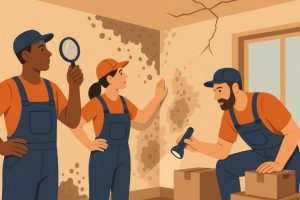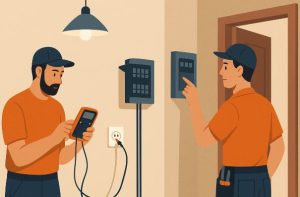Table of Contents
Are You Really Ready to Move Into Your New Home in London? You’ve signed the papers, packed the boxes, and scheduled the move, but have you inspected what’s waiting behind the front door? In the excitement of relocating, many people overlook critical checks that can affect safety, comfort, and even your finances.
Whether you’re renting a flat in Hackney or buying a house in Ealing, it’s essential to know what to look for before settling in. From faulty wiring and leftover rubbish to poor insulation and hidden damp, issues like these are often ignored until they become problems.
So, what should you really check before you move in? And how can you make sure your new home is clean, safe, and truly ready to live in?
Let’s break down the 10 most important things to look for before you move into your London home plus a practical solution if you discover it’s not quite as “move-in ready” as expected.
What Should You Do Before Moving Into a New Home in London?
Moving to a new home can be one of the most exciting transitions in life, but it’s also a process that demands planning, observation, and a bit of investigation.
Whether you’re moving into a rented flat in Camden or buying a semi-detached home in Walthamstow, knowing what to look for before you carry your boxes through the front door can save you a lot of stress.
Many residents in London rush to decorate or unpack, only to discover heating problems, poor drainage, or even piles of rubbish left behind. The key to a smooth move lies in doing the right checks at the right time.
Is It Worth Doing a Full Property Check Before Moving In?

Absolutely. A full property inspection not only gives you peace of mind but also protects your time, finances, and comfort. For homebuyers, it’s crucial to make sure the investment is sound.
For renters, any hidden damage or disrepair might affect your quality of life and even lead to disputes with landlords. Catching these issues early can help you negotiate fixes, plan renovations, or even delay moving in until problems are resolved.
You may also identify legal obligations the property owner must meet, such as energy efficiency, gas safety certification, or ensuring the home is free of environmental hazards like damp or asbestos.
How Can Rubbish Clearance Help Before You Unpack?
One of the most overlooked steps in moving is ensuring that the property is clean, cleared, and free of junk left by previous occupants.
Old mattresses, broken appliances, renovation debris, and forgotten furniture are common in London homes especially in rentals or properties sold as seen.
While cleaning might seem like a simple task, waste removal often requires more than just bin bags. In many cases, large or bulky items need to be professionally disposed of, especially if you’re short on time before the moving van arrives.
That’s where services like same day waste removal in London come in. They ensure your new property is clutter-free, hygienic, and move-in ready within hours and ideal for tight moving schedules or same-day key exchanges.
10 Things to Check Before Moving Into a New Home in London
1. General Cleanliness and Leftover Waste

One of the most common oversights during a move is assuming the property will be spotless when you arrive. In reality, many homes especially rentals or those recently vacated, may still contain remnants from previous occupants.
This can include general rubbish, broken furniture, old appliances, and even personal belongings left behind in lofts, sheds, or under sinks.
You should do a room-by-room walkthrough before moving your belongings in. Pay attention to areas that are often neglected, such as under kitchen units, in built-in wardrobes, or around outdoor bins.
If there’s any sign of old rubbish or junk, it’s best to deal with it before your own items start arriving. Trying to settle in while stepping over a heap of old packaging, damaged furnishings, or construction debris only makes the process more stressful.
If the waste left behind includes heavy or bulky items such as mattresses, garden waste, or broken white goods, consider whether you’ll realistically be able to dispose of it yourself.
Most local councils in London have strict rules on household waste, especially in flats or shared access buildings. It’s often more efficient and hygienic to clear the property professionally before you begin unpacking.
2. Heating and Hot Water Functionality

Comfort in your new home depends significantly on how well the heating and hot water systems function, especially in a city like London where winters are cold and damp. Unfortunately, issues with heating often go unnoticed until the first cold night after moving in, which can make the transition especially difficult.
You should test the heating system thoroughly before moving day. Start by turning on the central heating and checking each radiator in the house.
Are they warming up evenly? Are there any cold spots or noisy pipes? Uneven heat distribution may point to trapped air in the system or a circulation issue.
Run hot water from all taps and check how quickly it becomes warm. If the water takes a long time to heat, fluctuates in temperature, or has an unusual smell or colour, it may indicate problems with the boiler or pipework. Make sure you’ve seen a recent service record for the boiler and check that it meets safety regulations.
For rented properties, landlords are legally required to provide safe, working heating and hot water. For homeowners, understanding the age and condition of your boiler is critical, as replacements can be costly.
3. Signs of Damp, Mould, or Structural Issues

Dampness is one of the most persistent and potentially damaging problems found in London homes, particularly in basement flats, older properties, and homes with poor ventilation. Unfortunately, damp can often be masked by a fresh coat of paint or hidden behind furniture, only becoming noticeable after weeks of occupancy.
Look closely at the corners of ceilings and floors, especially in bathrooms, kitchens, and behind radiators or cupboards. Peeling paint, discolouration, black marks, or a musty smell are all indicators of moisture build-up. Also, check window sills and frames, as condensation often leads to mould in these areas.
Mould isn’t just a cosmetic problem. It can aggravate respiratory conditions and lead to long-term health issues. If it appears extensive or persistent, you may need to consider professional remediation.
You should also check for more serious structural issues such as cracks in walls, bowed ceilings, or doors that don’t fit their frames properly. These signs may indicate foundation movement or moisture damage and should be assessed by a qualified surveyor, particularly before finalising a home purchase.
4. Electrical Safety and Lighting

Electricity is one of the most essential utilities in any home, yet problems with the wiring are among the most dangerous if ignored. London properties particularly period conversions often suffer from outdated electrical systems that don’t meet modern safety standards.
Before moving in, turn on all lights, plug in basic appliances, and use a charger to test each socket. Watch out for buzzing noises, flickering lights, or sockets that spark or feel loose when used. These could point to faulty fittings or underlying issues with the circuitry.
It’s important to establish whether the home has a valid Electrical Installation Condition Report (EICR), which certifies that the wiring is safe and up to date.
For rented properties, this is a legal requirement, and the landlord must provide one. Homebuyers should request this document as part of their survey or ask for one to be conducted.
In addition to the physical checks, confirm the number of sockets available in each room. Modern households require more access points than ever, and relying on extension leads or adapters is not only inconvenient but can also pose a fire risk.
5. Doors, Windows, and Insulation

Doors and windows serve multiple roles in a home. They provide security, ventilation, insulation, and noise reduction. During your pre-move inspection, test every door and window to ensure they open and close properly, latch securely, and are free from cracks or broken seals.
If you feel a strong draft near the edges of the frame, it may indicate that the sealant or insulation has deteriorated. This can significantly impact your energy bills over time, especially if the property has single glazing or older wooden frames.
In a city like London, where both winter cold and urban noise are concerns, poorly insulated windows can also affect your comfort and quality of sleep.
Doors are particularly exterior ones and they should fit their frames properly and lock securely. If the door sticks, swings open without resistance, or rattles in its frame, there may be issues with the hinges, flooring alignment, or even subsidence.
Internal doors should also be checked, especially in shared households or HMOs, where fire safety regulations may require fire-rated fittings.
Additionally, observe the condition of window handles, restrictors, and latches. Replacing or repairing hardware might be a minor job, but catching it early helps avoid inconvenience once you’ve moved in.
6. Plumbing, Water Pressure, and Drainage

Water systems often go unnoticed during property viewings, but once you’re living in the space, poor plumbing can quickly become one of the most frustrating issues.
London properties, especially older buildings or flats that have been converted, can have irregular water pressure, outdated pipework, or hidden leaks.
Before moving in, check each tap individually. Run cold and hot water to see how quickly it flows and whether the temperature adjusts smoothly. Flush each toilet and listen to how long it takes to refill.
Gurgling sounds or slow drainage can suggest a blockage somewhere in the system. You should also inspect underneath kitchen and bathroom sinks for any signs of leaking pipes or water stains, which might indicate a longer-term issue.
Be alert for discoloured water, which could mean rusted pipes or a faulty tank system. In homes with water storage tanks that are still common in older London flats, it’s also worth confirming whether the system has been properly maintained or replaced.
Any lingering smells in sinks or drains may point to clogs in the waste system, which can require professional jetting or repairs.
7. Broadband and Mobile Signal Availability

In today’s world, a home without reliable internet or phone reception can be difficult to live in, particularly if you work from home, stream entertainment, or rely on smart home devices. Yet, not all areas in London have equal coverage, and some buildings may physically block mobile signals due to thick walls or outdated construction materials.
Check with the current occupants or the estate agent to find out which broadband providers are available in the area. Fibre-optic access varies widely depending on postcode and building type. Even some centrally located properties still rely on copper lines, which offer slower and less reliable service.
When it comes to mobile signal, don’t rely solely on coverage maps. Walk around the property while making a call or running a mobile data speed test.
Pay attention to dead spots, often found in basements, attics, or near thick structural walls. If signal quality is poor, you may need to invest in a signal booster or choose a provider with better coverage for your location.
8. Energy Performance and Efficiency

Understanding how energy-efficient your new home is can help you estimate running costs and reduce your environmental footprint. All homes in the UK are required to have an Energy Performance Certificate (EPC), which rates the property from A (most efficient) to G (least efficient). However, this rating alone doesn’t give you the full picture.
Look at practical signs of energy efficiency during your visit. Are there double-glazed windows? Does the home have roof insulation or cavity wall insulation? Is there a modern thermostat installed, perhaps with smart heating control? These are all indicators that the property has been improved to retain heat more effectively.
Energy-inefficient homes are more common in London than you might expect, particularly in Georgian, Victorian, and Edwardian buildings. High ceilings, single glazing, and uninsulated floors can make heating expensive.
If you’re buying, it’s worth considering the long-term cost of upgrades such as a new boiler or insulation. For renters, these factors may affect your decision or give you a basis to negotiate rent.
9. Local Environment, Amenities, and Transport

Your new home is more than just four walls, it’s part of a wider community. That’s why it’s important to assess the local environment as part of your moving preparations. While online listings often highlight local attractions, the best way to get a true sense of the area is by visiting it in person.
Walk around at different times of day to see what the atmosphere is like. Is it quiet and residential or lively and loud? Are there local shops, pharmacies, GP surgeries, or schools nearby?
Try to gauge the walkability and accessibility of everyday necessities. It’s also helpful to test public transport routes, especially if you’ll be commuting to work or school.
Look out for parking restrictions, residents-only zones, and the availability of visitor parking. In many London boroughs, parking permits are required and not always easy to obtain. If you cycle, check whether the building has secure bike storage. These practical details can significantly influence your daily life once you’re settled in.
10. Council Tax Band and Other Local Costs

Council tax is a recurring expense you’ll need to factor into your monthly budget. Every property in London falls under a specific council tax band, determined by its location and value.
However, two nearly identical homes can fall into completely different bands depending on the borough, which can mean a difference of hundreds of pounds per year.
Before moving, use the local council website to check the property’s official band and the amount currently charged. If you believe the band is too high, you can appeal, but it’s better to know in advance so you can plan accordingly.
In addition to council tax, check whether your new home is subject to any service charges or ground rents.
These are particularly common in flats, especially newer builds or converted blocks, where building maintenance, lighting, lift servicing, and cleaning of communal areas are covered by residents. These charges are usually billed monthly or quarterly and can add significantly to your living costs.
Conclusion
Moving into a new home in London is more than just collecting the keys, it’s about ensuring the space is safe, efficient, and ready for everyday life.
By carrying out these essential checks before you unpack, you protect yourself from hidden problems that could affect your comfort, finances, and peace of mind.
From inspecting the heating system to assessing the local area, each step helps you make a confident and informed start.
And if the property has been left with unwanted rubbish or bulky waste, clearing it quickly and professionally ensures your new beginning starts on the right note. A clean, clutter-free environment is not only easier to move into, it’s easier to turn into a home.
FAQs
What should I do if there is rubbish left in the property before I move in?
You should arrange for it to be cleared before moving day. If it’s too much to handle alone, consider using a professional waste removal service.
How can I check if the heating and hot water are working properly?
Turn on the boiler, test each radiator, and run all hot taps. Uneven heating or delayed hot water could signal a problem.
Is it necessary to inspect plumbing before moving in?
Yes. Run all taps, flush toilets, and check under sinks for leaks or slow drainage, which could point to underlying plumbing issues.
Why should I test the broadband and mobile signal?
Poor connectivity can affect remote work and communication. Test coverage inside the home and check broadband availability in your area.
What is the importance of checking the council tax band?
Knowing the band helps you understand your monthly council tax charges and avoid unexpected costs after moving in.


